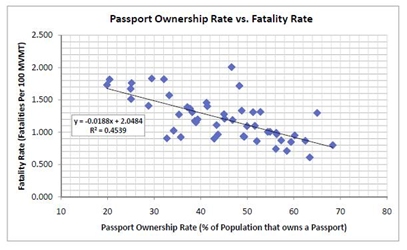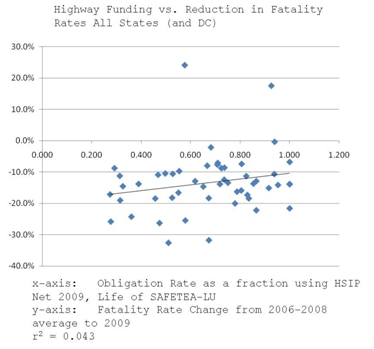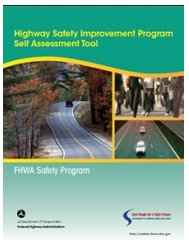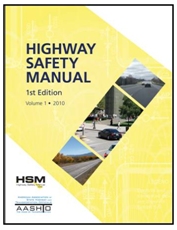U.S. Department of Transportation
Federal Highway Administration
1200 New Jersey Avenue, SE
Washington, DC 20590
202-366-4000
Best for printing: scfall201.pdf (567 KB)

In this issue:
Resources and Tools for the Focused Approach
Have You Scheduled Your Assessment Yet?
Safety Data Contest Looks at Creative Answers to Difficult Questions
Highway Safety Improvement Program Self Assessment Tool *Now Available*
Suite of HSM Support Tools Set to be Released
FHWA Issues Guidance on Minimum Roadway Safety Data Collection
 Anthony T. Furst Acting Associate Administrator, Office of Safety |
In the time I've been with the Office of Safety, what strikes me, as it has in many of the other jobs I've held in government service, is the daunting complexity of interests and partners that need to be engaged and aligned to fulfill our mission - making our transportation network safer. Each of these interests and partners have their own agenda and come at the issue of safety from their own perspective. What works for one doesn't necessarily work for another, which means we need to find common ground in order to move forward. It is here that Safety has a distinct advantage - reconciling differences is easier when all the interests are working toward a common objective. We also have the advantage of a common metric - reducing lives lost and preventing serious injuries. This unifying mission, this common sense of purpose, is critical. While the dynamics of aligning each party's interests is something that will always be in play, it is far easier to find a path forward when the complex array of interests and partners have a common objective and agree on how it will be measured.
At US DOT, the Safety Council aligns Departmental activities in support of our safety mission. This Council is chaired by the Deputy Secretary and covers the full breadth of Departmental resources and some of our key governmental partners outside US DOT. Routinely assessing how Departmental assets can best mesh together and tackling common problems collectively ensures we are providing the best value to the taxpayer and most effectively utilizing the vast array of Departmental resources. Along those same lines, the Office of Safety and our partners at Turner-Fairbank and the Resource Center are pursuing a thorough review and assessment of our strategic goals and objectives, programs, and activities to better align and focus FHWA safety resources. This effort will ensure we are taking maximum advantage of all our talents and are in the best position to work collaboratively with our partners, leveraging their assets and ours. As I have found to be the case across all of FHWA, the level of talent and dedication this organization can bring to bear is impressive and makes me very comfortable that this effort will serve the Safety Discipline and the Safety community extremely well for years to come.
It has been an especially rewarding, challenging, and, yes, enjoyable 4 months being the Acting Associate Administrator for the Office of Safety. I want to take this opportunity to again thank the Office for the exceptional and professional support you have so generously and reliably provided to me and for your dedication to the mission of the Office - you are making a difference.
[ Return to list of contents. ]
What is the Focused Approach to Safety?
The Focused Approach to Safety provides additional resources such as technical expertise, tools and training to eligible high-priority States to help them address the Nation's most critical safety challenges. Each eligible State participating in the Focused Approach will be assisted in addressing fatality reductions in any one or all of three critical focus areas. Infrastructure-oriented improvements to reduce roadway departure, intersection, and pedestrian crashes have been identified as providing the greatest potential to reduce highway fatalities.

Can my State participate in the Focused Approach?
Although the Focused Approach targets its resources to eligible Focus States, all States can benefit from the tools and resources identified in the Focused Approach.
What assistance can eligible focus States receive?
Eligible focus States participating in the Focused Approach will have access to assistance in several different formats. States can receive technical assistance for activities such as data analysis and action plan development assistance from initiation to implementation of infrastructure improvement plans. In addition, training is available in several formats, including classroom-based workshops, online webinars, and hard-copy training materials. Support is also available for a wide range of analysis tools and countermeasure implementation activities.
Where can I find more information about the Focused Approach to Safety?
You can find more information about implementing the Focused Approach to Safety and available tools and resources by visiting the Focused Approach to Safety website at http://safety.fhwa.dot.gov/fas/ or contacting Melonie Barrington, P.E., Melonie.Barrington@dot.gov or (202) 366-8029.
[ Return to list of contents. ]
A guidebook, fact sheet, and talking points for outreach are available to provide additional information and to assist States in implementing the Focused Approach to Safety. These tools are available to both focus States and non-focus States to support them in meeting their targeted safety goals and their Strategic Highway Safety Plan (SHSP) fatality reduction goals.

Resources and Tools:
Fact Sheet - Summarizes the overall program concept and key features for all stakeholders.
Talking Points for Outreach - Provides talking points to assist in the Focused Approach to Safety discussion with stakeholders.
Toolkit - Provides a list of support tools by focus area.
Guidebook - Concise resource containing the program purpose, benefits, history, focus State eligibility criteria, steps for success, initial deployment checklist, and highlights.
Program Coordinator:
Melonie Barrington
Melonie.Barrington@dot.gov
(202) 366-8029
Roadway Departure:
John Dewar
john.dewar2@dot.gov
(202) 366-2218
Intersections:
Jeff Shaw
jeffrey.shaw@dot.gov
(708) 283-3524
Pedestrians:
Tamara Redmon
tamara.redmon@dot.gov
(202) 366-4077
[ Return to list of contents. ]
High-quality data are the foundation for effective decisions on highway safety. The Roadway Safety Data Partnership (RSDP), a collaboration between States and the Federal Highway Administration (FHWA), aims to improve the collection, analysis, management, and expandability of roadway data for use in safety programs and decision making. The State roadway safety data capability assessment is key to helping each State understand its existing capabilities and the steps to reach its self-identified goals. The process will help States identify actions to overcome gaps and integrate improvements into their safety plans.

For more information, visit http://safety.fhwa.dot.gov/rsdp. To schedule your State's assessment, contact Heather Rothenberg at 202-366-2193 or heather.rothenberg2@dot.gov.
[ Return to list of contents. ]
Is possession of a passport an indicator of your level of highway safety? Are HSIP obligation rates meaningful indicators of highway safety? These are the types of unusual findings that FHWA safety data contest participants found earlier this summer when they entered the Safety Discipline data contest. The contest was coordinated by the Analysis and Evaluation Team as a way to highlight the value of different kinds of data analyses and presentation for highway safety programs.

Ryan Brumfield, a PDP in the Office of Safety, found that States with a higher percentage of the population who own passports have lower crash rates. He discovered this as he combined data from the state safety data sheets with data from other sources including the Census Bureau, Centers for Disease Control, and others. His analysis considered the potential relationship between highway fatality rates and individual characteristics such as health, education, income, and a few others. Ryan offered the following thoughts about his analysis, "Theoretically, attitudes and beliefs are predictors of behavior, including the likelihood of citizens to partake in risky behavior when driving...The link between these variables and road safety is certainly not direct, but by looking at the analysis from a 5000 foot view, we can hypothesize why these strong correlations exist."
Rick Drumm wondered whether safety professionals are considering the best measures for performance reporting. Given the increased importance placed on performance-based programs, this is a difficult question with no obvious answer. One of the areas Rick examined is the relationship between Highway Safety Improvement Program obligation rates and highway fatality rate changes. As is often the case with good analysis, Rick's results raised more questions, including whether the lag time between obligation and results makes it difficult to draw correlations between spending and fatality rate reduction. It might take 5 to 7 years from the time funds are obligated through the completion of a project to the point where an adequate amount of time post-completion has passed to measure potential improvements. Rick raised additional questions in his submission, "In these days of metrics...safety engineers are continually being asked to move the numbers. At the same time, we are being measured by various criteria which may or may not have an influence on the numbers...What actions could we take that will move that numbers? Also, how should we analyze the data?"
Ryan and Rick were the winners of the Office of Safety's first data contest. The contest encouraged FHWA staff at headquarters, the divisions, and the Resource Center to "be a safety data superstar" by conducting creative analysis of data from the DFS/State Safety Data Sheets released in March 2011. The data sheets include information in tables for all States and the US as well as State snapshots that include all of the data for each State in a one-page printable format:

Four honorable mentions were also awarded.
Winners:
Honorable mentions:
For more information about the State Safety Data Sheets or to learn more about the contest entries, please contact Heather Rothenberg at heather.rothenberg2@dot.gov.
[ Return to list of contents. ]
 The FHWA Office of Safety recently published the Highway Safety Improvement Program (HSIP) Self Assessment Tool as a companion document to the previously released HSIP Assessment Toolbox. The HSIP Self Assessment Tool describes an approach to self assessment that allows users to evaluate specific aspects of the HSIP process. The tool consists of a number of questions designed to provide those with HSIP management responsibilities information to assess their programs, policies, and procedures against many of the recommended HSIP practices in use today. The HSIP Self Assessment Tool is available in electronic format only at http://safety.fhwa.dot.gov/hsip/resources/fhwasa10017.
The FHWA Office of Safety recently published the Highway Safety Improvement Program (HSIP) Self Assessment Tool as a companion document to the previously released HSIP Assessment Toolbox. The HSIP Self Assessment Tool describes an approach to self assessment that allows users to evaluate specific aspects of the HSIP process. The tool consists of a number of questions designed to provide those with HSIP management responsibilities information to assess their programs, policies, and procedures against many of the recommended HSIP practices in use today. The HSIP Self Assessment Tool is available in electronic format only at http://safety.fhwa.dot.gov/hsip/resources/fhwasa10017.
The HSIP resources website (http://safety.fhwa.dot.gov/hsip/resources/#pubs) also includes a supplemental score sheet in MS Excel and responses to frequently asked questions. For technical support in preparing for or conducting an HSIP self assessment, please contact Karen Yunk in the Office of Safety at 609-637-4207 or karen.yunk@dot.gov.
[ Return to list of contents. ]
The 2010 Highway Safety Manual (HSM) provides highway agencies with the information and tools needed to facilitate quantitative safety consideration in roadway planning, design, operations, and maintenance. As more States begin to accept and implement the HSM, FHWA continues to identify and address their needs as they work to improve the safety of our Nation's roadways. We have been working very closely with the American Association of State Highway and Transportation Officials (AASHTO), the Transportation Research Board (TRB), and researchers across the Nation to develop training, guidance, and other tools that will assist States with the many facets of implementation. Over the next few months, we will be releasing a series of important publications that will meet various needs for the States.
 The HSM Training Guide is a resource document for State departments of transportation (DOT) that are developing HSM training plans. The guide focuses on HSM training currently available to State and local agencies that are considering implementing the HSM and identifies additional courses under development. Several training opportunities exist in the areas of highway safety and safety analysis, but the guide focuses only on courses directly applicable to content in the HSM and provides information only on those courses given by NHI, FHWA and ITE. Training Guide is currently available electronically at http://safety.fhwa.dot.gov/hsm/training/hsmguide.pdf.
The HSM Training Guide is a resource document for State departments of transportation (DOT) that are developing HSM training plans. The guide focuses on HSM training currently available to State and local agencies that are considering implementing the HSM and identifies additional courses under development. Several training opportunities exist in the areas of highway safety and safety analysis, but the guide focuses only on courses directly applicable to content in the HSM and provides information only on those courses given by NHI, FHWA and ITE. Training Guide is currently available electronically at http://safety.fhwa.dot.gov/hsm/training/hsmguide.pdf.
The HSM Implementation Guide for Managers is written for managers within DOTs charged with leading and managing various programs related to the project development process and safety programs. It outlines what the HSM is (and is not), how it "fits" with other core technical documents and policies, and what the potential benefits of its use can be. In addition, HSM Implementation Strategies for Managers offers guidance to senior agency management in identifying and overcoming both internal and external barriers to implementation and integration of the HSM. Managers Guide is currently available electronically at http://safety.fhwa.dot.gov/hsm/hsm_mgrsguide/hsm_mngrguide.pdf.
Focusing on practitioners, the HSM Applications Guidebook is a planning-level tool for State and local agency staff seeking to implement and institutionalize the HSM. The Guidebook is intended to help practitioners understand how the HSM adds value and includes specific guidance for integrating the HSM into identified processes and programs within select disciplines such as Safety, Planning and Environment, Design, and Operations. In addition, the Guidebook includes examples of how the HSM is currently being applied. Will be available electronically in the near future.
FHWA has developed several HSM case studies that describe how the HSM methodologies have been applied in Idaho, Ohio, and Florida. Idaho used predictive methods to perform a transportation study on an 11-mile corridor. Ohio is implementing a new roadway safety management process using SafetyAnalyst software tools, which support Part B of the HSM. Florida used the HSM's crash prediction methodologies to select an alternative on a four-lane divided highway. We will develop more case studies and add them to this collection as we identify additional notable applications of HSM methodologies. Case Studies are currently available electronically at http://safety.fhwa.dot.gov/hsm/#cstd.
These four resources together are intended to support HSM deployment and help ensure successful implementation by providing tailored guidance to the appropriate stakeholders at all levels of government.
[ Return to list of contents. ]
While many states are pursuing improvement in highway safety data analysis and the usage of analytical tools, many are asking what types of roadway data they should be collecting. The Government Accountability Office asked FHWA a similar question in 2009, when they issued a report on the effectiveness of the HSIP program (GAO-09-35). FHWA's Office of Safety, and an assembled expert working group, ended a year and a half of analysis and deliberation on this issue when they issued guidance on August 1, 2011, that describe a minimum level of roadway data elements that States should be collecting for their HSIP program analysis.
| Roadway Segment | Intersection | Ramp/Interchange |
|---|---|---|
| Segment ID* | Intersection ID | RampID* |
| Route Name* | Location | Date Opened to Traffic |
| Alternate Route Name* | Intersection Type | Start Location |
| Route Type* | Date Opened to Traffic | Ramp Type |
| Area Type* | Traffic Control Type | Ramp/Interchange Configuration |
| Date Opened to Traffic | Major Road AADT | Ramp Length |
| Start Location* | Major Road AADT Year | Ramp AADT* |
| End Location* | Minor Road AADT | Ramp AADT Year* |
| Segment Length* | Minor Road AADT Year | |
| Segment Direction | Intersection Leg ID | |
| Roadway Class* | Leg Type | |
| Median Type | Leg Segment ID | |
| Access Control* | ||
| Two-Way vs. One-Way Operation* | ||
| Number of Through Lanes* | ||
| Interchange Influence Area on Mainline Freeway | ||
| AADT* | ||
| AADT Year | ||
| *Highway Performance Monitoring System full extent elements. | ||
This new guidance (found online at http://safety.fhwa.dot.gov/tools/data_tools/dcag.cfm) outlines the 38 data elements that are a priority for State and local agencies to collect on their roadways in order to conduct substantive enhanced safety analyses. These data elements overlap with existing Highway Performance Monitoring System (HPMS) data elements and can be integrated with the crash data traditionally collected to provide a basis for better safety investment decisions. The guidance also identifies prerequisite conditions for using the elements and a recommended roadway prioritization methodology in addition to a listing of the elements (see table above).
The list of elements was determined through an extensive research process outlined in a newly released background report (FHWA-SA-11-39) and is based on the Model Inventory of Roadway Elements (MIRE). Another aspect of the new guidance is that it acknowledges that additional resources will be needed to accomplish collection of this data. FHWA also developed a market analysis report (FHWA-SA-11-40), which estimates the unit costs for the collection of this data. The report is intended to assist States in developing better estimates of their own potential costs to implement the guidance.
[ Return to list of contents. ]
Values do not define what an organization does (as the mission does), or what an organization aspires to (as the vision does), but rather how the organization carries out its responsibilities. Our values define the importance we place on our customers, stakeholders, employees and on FHWA itself as a place to work.
FHWA Core Values, shown below, are based on what the members of our organization believe to be important and should be modeled by all employees, at all levels of the organization.
 |
How do you exhibit the FHWA Core Values?Collaboration: Personal Development: Integrity: Public Service: |
[ Return to list of contents. ]
The Safety Compass newsletter is published for internet distribution three times a year by the:
FHWA Office of Safety
1200 New Jersey Ave. SE
Room E71-105
Washington, DC 20590
The Safety Compass can also be viewed at http://safety.fhwa.dot.gov
Editor-in-Chief:
Karen Timpone
karen.timpone@dot.gov
Your comments and highway safety-related articles are welcomed. This newsletter is intended to increase highway safety awareness and information and to provide resources to help save lives.
You are encouraged to submit highway safety articles that might be of value to the highway safety community. Send your comments, questions and articles for review electronically to Karen Timpone, karen.timpone@dot.gov.
